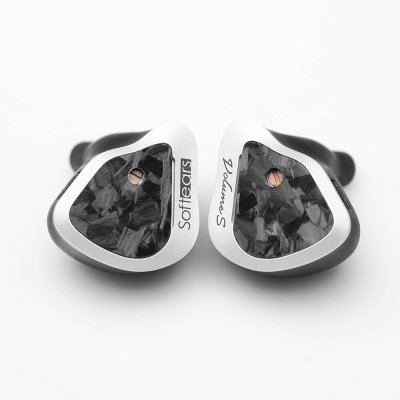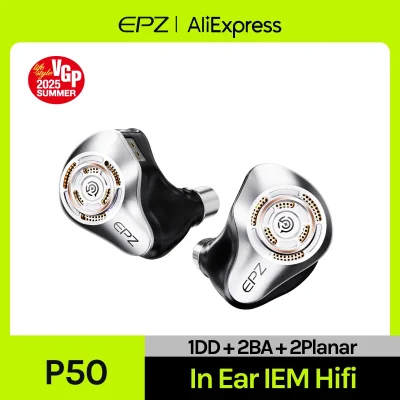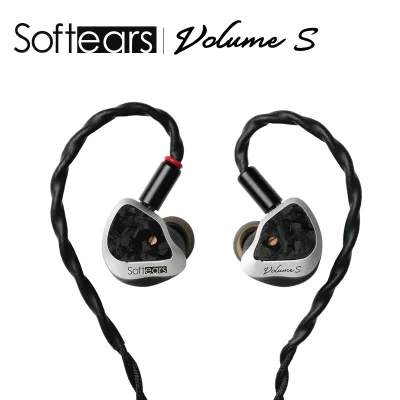Softears Volume S and EPZ P50 use 2DD+2BA and 1DD+2BA+2Planar driver setups respectively. Softears Volume S costs $320 while EPZ P50 costs $205. Softears Volume S is $115 more expensive. Softears Volume S holds a clear 0.6-point edge in reviewer scores (7.8 vs 7.2). User ratings place Softears Volume S at 8.2 and EPZ P50 at 9.5. Softears Volume S has slightly better bass with a 0.4-point edge, EPZ P50 has slightly better mids with a 0.3-point edge, EPZ P50 has better details with a 0.9-point edge and EPZ P50 has significantly better imaging with a 1.2-point edge.
Insights
| Metric | Softears Volume S | EPZ P50 |
|---|---|---|
| Bass | 8 | 7.6 |
| Mids | 7.6 | 7.9 |
| Treble | 7.3 | 7.4 |
| Details | 6.7 | 7.6 |
| Soundstage | 7.4 | 7.3 |
| Imaging | 6.5 | 7.7 |
| Dynamics | 6.4 | 6.5 |
| Tonality | 7.8 | 7.2 |
| Technicalities | 7.4 | 7.2 |
Softears Volume S Aggregated Review Score
Average Reviewer Scores
Average Reviewer Score:
7.8Strongly Favorable
EPZ P50 Aggregated Review Score
Average Reviewer Scores
Average Reviewer Score:
7.2Generally Favorable
Reviews Comparison
Softears Volume S reviewed by Audio Amigo
Youtube Video Summary
Softears Volume S follows the 2022 Volume and steps into a fiercely competitive ~$320 bracket with a seriously premium kit: a gorgeous leather case, modular screw-on terminations, both standard and Ultra Clear eartips, IM booties, and tiny screwdrivers for the on-board potentiometer. The stealthy black resin shells with exposed carbon-fiber faceplates feel solid and fit well thanks to slim nozzles; just note there’s no nozzle mesh. The big caveat is the cloth-sheathed stock cable—ergonomically nice but with heavy microphonics. Two tunings are selectable: low-impedance (≈10Ω) and high-impedance (≈31Ω). The low-impedance mode is the keeper; it’s easy to drive yet sensitive to source output impedance, so a dongle under 1Ω is recommended to avoid unintentionally shifting the tonality.
In low-impedance mode the signature is neutral-natural, a flatter, more mid-centric take on “new-meta.” Bass offers quality over quantity: textured, punchy, and responsive without tipping into basshead territory. The mids are the star—clean, warm-tinged lower mids give male vocals body while female vocals sit forward without shout, keeping timbre natural. Treble is smooth, airy, and non-fatiguing, avoiding metallic glare while preserving sparkle. Technical performance is confidently above average for the price: imaging & stage feel wide and well-layered, with good separation and resolution that rewards attentive listening without forcing it.
Positionally, think “Kato upgrade”: smoother treble, better bass texture, and a refinement that many will prefer. Versus spicier rivals like DaVinci, Project Meta, Dusk DSP, or Mega 5 EST, the Volume S sounds more controlled and “correct,” trading some slam and upper-air fireworks for coherence and timbre. It won’t thrill bass lovers, treble heads, or detail chasers seeking a spotlighted presentation; everyone else gets a superb all-rounder that feels benchmark-worthy—the HD600/650 vibe for IEMs. Verdict: you should buy this if a do-it-all, neutral-natural tuning is the goal; just mind your source impedance and consider swapping the cable to kill the microphonics.
Audio Amigo Youtube Channel
Buy Softears Volume S on HiFiGO
Ad
Price: $290
Buy Softears Volume S on HiFiGO
EPZ P50 reviewed by Audio Amigo
Youtube Video Summary
EPZ P50 comes as a tribrid at $185 with a surprisingly complete kit: a sturdy leatherette case, modular 3.5/4.4mm terminations, three silicone tip sets, and a cleaning cloth. The resin shells are semi-custom with aluminum faceplates; comfort is generally good but anatomy-dependent, and the stock cable—while well finished—runs on the stiff side. A standout twist is the factory customization option (~$225 total for the “Grindphones” style), which notably doesn’t alter the tuning in any meaningful way. The set is easy to drive, shows minimal change with impedance adapters (a touch warmer/more vocal-forward), and avoids pressure issues thanks to smart internal venting.
Sonically, tuning sits as a controlled, mild V: bass is just north of neutral with pleasing texture and impact, mids stay clean with an engaging female-vocal emphasis, and treble adds airy sparkle without turning tizzy—though insertion depth can trigger length-mode variability for some ears. Technical chops impress at the price: detail retrieval punches up, imaging is precise with good separation, and stage reads average but coherent. Against peers, P50 feels more resolving than Kiwi Ears K4 (trades bigger bass/sparkle for better mid clarity), brighter and more vocal-present than the neutral-leaning Ziigaat Lush, and echoes a Dunu Da Vinci vibe with less bass. Verdict: tremendous value and a terrific pick for vocal-centric libraries—highly recommended to audition first if treble sensitivity or fit quirks are a concern.
Audio Amigo Youtube Channel
Buy EPZ P50 on Aliexpress
Ad
Price: $199
Buy EPZ P50 on Aliexpress
Softears Volume S reviewed by Super* Review
Youtube Video Summary
The Softears Volume S at $320 sets a new tonal benchmark for IEMs in its price range. It arrives in solid packaging featuring a zippered carry case (a bit large but functional), protective earpiece pockets that might feel overkill for some, and two excellent sets of ear tips – including Softears' own highly-regarded Ultra Clear tips. Build quality is generally fantastic, highlighted by a resin shell, a comfortable paracord-style cable with a low-profile, user-swappable termination system, and recessed 2-pin connectors. While the aesthetics might feel a bit old-school to some, the fit is comfortable and stable due to its semi-custom shape and longer nozzle, making it secure enough for sleeping. A small screwdriver-adjustable tuning switch offers a secondary, brighter Harmon-like sound signature, though the default tuning is preferred.
The default sound signature is a warm-tilted neutral, delivering exceptional natural timbre and tasteful bass boost. This bass stands out for its exceptional physicality – punchy and impactful without being overbearing – alongside articulate sub-bass that’s easy to follow. Combined with well-defined transients, particularly in the upper-midrange, it creates a satisfyingly rich and dense presentation. While spatial effects and imaging are competent but not standout, the overall tonality and bass quality are remarkably refined. Comparisons show it offers a better tonal balance and bass control than the bassier Dunu DaVinci, significantly more body and richness than the brighter, thinner Moondrop Blessing 3, and trades blows with the Moondrop Dusk – the Volume S providing superior density and mid-bass presence versus the Dusk's more open, spacious presentation.
Ultimately, the Softears Volume S earns a full five-star rating. It might not be the absolute most technically dazzling IEM, but its fantastic tonal balance, unique bass physicality, and overall refinement make it a compelling choice. For $320, it delivers a sound signature that feels just right – rich, satisfying, and universally appealing – challenging more expensive offerings and establishing itself as a top contender in its class.
Super* Review original ranking
Super* Review Youtube ChannelEPZ P50 reviewed by Super* Review
Youtube Video Summary
EPZ’s P50 feels like a breakout for the brand: a compact, medium-small shell with a vented faceplate that’s marketed as “open-back,” yet isolates like a typical IEM. The unboxing is tidy at this price—carry puck, a real microfiber cloth, and two sets of generic tips—while the modular cable (screw-lock swappable termination) is handy if a bit thin, stiff, and kink-prone; the 2-pin plug sits slightly proud of the socket and the “R” marking is visible on the outside. The long nozzle (~5.5 mm diameter) can push fit depth, so shorter tips (e.g., NF Audio-style) help; once set, stability and comfort are excellent. Overall build looks clean and modern, if a touch editorial compared with EPZ’s other shells.
Sonically, P50 embraces the current tilted diffuse-field “new meta” with a mostly neutral, natural presentation and a later-rising, sub-bass-centric lift that gives bounce rather than mid-bass thump. There’s a hint of extra presence around the 4–5 kHz region that adds macro-contrast—vocals pop with definition and separation is crisp—while upper treble stays safe: cymbals are clean but a bit light in weight. Bass is tight and incisive rather than slammy; micro-texture on vocals is good, though the set favors that big, “stagey” contrast over ultra-fine grain. It’s easily EPZ’s best tuning so far: clear, organized, and engaging without drifting from neutral-ish aims.
Against peers, Kiwi Ears K4 tracks a similar target but sounds lower-contrast and can blur on dense mixes; P50 hits harder on transients, images more cleanly, and keeps busy tracks sorted, while K4 offers a richer midrange with “frothier” treble. Versus the Binary Chopin, Chopin is warmer, fuller, and more mid-bass driven—more “analog” and atmospheric—with deeper perceived space but a bulkier fit; P50 is leaner, clearer, and the least bass-forward of the three. Verdict: a confident 4/5 for delivering a small, comfy fit and a clean, contrasty neutral that competes squarely around $200–$250. If the brief is “neutral with a bit of drama,” this is a strong pick—and a promising sign of where EPZ can go next.
Super* Review original ranking
Super* Review Youtube ChannelSoftears Volume S reviewed by Jaytiss
Jaytiss Youtube Channel
EPZ P50 reviewed by Jaytiss
Jaytiss Youtube Channel
Softears Volume S reviewed by Gizaudio Axel
Gizaudio Axel original ranking
Gizaudio Axel Youtube ChannelEPZ P50 reviewed by Gizaudio Axel
Softears Volume S reviewed by Jays Audio
Youtube Video Summary
The Softears Volume S emerges as a standout vocal specialist under $500, often described as a "mini studio 4“ due to similar frequency graphs. However, it trades some treble detail for superior scaling and a heightened focus on the mid-range, particularly vocals, while adding a touch more mid-bass oomph. This treble reduction allows the music to breathe, creating a more immersive and musical experience that pulls the listener deeper into the sound compared to the Studio 4, without sacrificing a sense of space or leaving the bass and treble feeling inadequate. Though not bass-heavy or treble-head oriented, the low-end provides enough thump and the highs enough air to avoid sounding lean or dark, resulting in a presentation that's slightly less technical and balanced than the Studio 4 but excels in vocal delivery and engagement.
A key feature is the tuning switch which boosts upper mids and treble while lowering the bass, effectively transforming the sound into a cleaner, more technical version of Harman 2019, even surpassing the Studio 4 in detail retrieval in this mode. However, this boosted configuration can sound shouty, lean, and overly clinical for many preferences, lacking the thickness of the stock tuning and scaling less effectively at higher volumes. The stock tuning, preferred for its vocal prowess, truly comes alive with increased volume. The included clear tips are recommended for a slight treble lift and comfort, and the bundled USBC adapter adds a subtle amount of sub-bass rumble, though the low-end remains clean and controlled, reminiscent of leaner sets like the Pilgrim, not providing heavy slam.
While the Studio 4 remains a solid, well-balanced all-rounder, especially on sale around $350, and alternatives like the EM10 (more detailed), Supermix 4 (better value), the Volume S carves its niche with exceptional vocal performance at higher volumes using the stock tuning. Its main drawbacks involve the confusing switch design (requiring opposite positions on each earpiece for the same tuning with no clear indicators) and the pricing debate; using non-branded drivers suggests a more appropriate price point would be $200-$250 rather than $300. Despite these quirks and marketing claims about the passive radiator's role (its actual impact being debatable), the Volume S delivers a great sounding, flexible IEM offering distinct sonic profiles based on volume level and switch position.
Jays Audio Youtube Channel
EPZ P50 reviewed by Jays Audio
Youtube Video Summary
The EPZ P50 comes in hot as a new tribrid and a potential $200 neutral benchmark, trading sterile restraint for a more vocal-centric presentation. Versus the MEGA5EST, vocals sit a touch more forward—adding emotional weight and clarity—while the MEGA5EST still edges it on sheer smoothness and EST “air.” Compared to Meteor, the P50 fills in the lower mids, dials back 1–3 kHz glare, and opens the top end a bit; Meteor stays a hair softer up top. The catch is bass: the P50’s DD is competent but not a sub-bass shaker—expect clean rather than authoritative slam.
Against peers, the P50 sounds fuller and more natural than Supermix 4 (which is brighter and more “hi-fi” energetic), and it trades blows with Odyssey: Odyssey brings better bass texture and treble micro-detail, while the P50 delivers superior vocal clarity and a touch more air. It excels at mid-volume listening—Volume S needs more gain to bloom—and outclasses lighter, air-tilted sets like “K4” style tunings when male vocals or body are the priority. Accessory game is strong too: a nicer cable and a genuinely sturdy hard-leather case sweeten the deal. Not the most “unique” flavor and not for bassheads, but as a balanced, clean, vocal-forward option around $200, P50 is an easy recommendation for those chasing neutrality without the vanilla.
Jays Audio Youtube Channel
Softears Volume S reviewed by Paul Wasabii
Youtube Video Summary
Softears Vol S leans into a mid-bass emphasis that is uncommon among recent hybrids, pairing boosted sub- and mid-bass with full-bodied, lower-mid vocals. The result is a naturally thick, lush midrange that favors genres needing body over sparkle, and the relaxed treble beyond ear-gain lets volume changes scale bass and treble together. At higher listening levels the set can hit hard and verge on bass fatigue, but within moderate levels it fills a clear gap left by leaner U-shaped tunings.
Trade-offs are plain: the upper-treble sits back, so stage is smaller and overall resolution is lower versus airier peers; some upper-end information gets masked by the bass weight. The impedance switch adds a bit of brightness but also trims the pleasing volume scaling, bringing limited benefit. Not a $300 class leader, yet a well-tuned alternative for listeners who prioritize natural, weighty mids over maximum air and sparkle.
Paul Wasabii Youtube Channel
EPZ P50 reviewed by Paul Wasabii
Youtube Video Summary
The EPZ P50 is a five-driver open-back hybrid (1DD + 2BA + 2 micro-planars) that arrives with a solid accessory kit and a sensible price. The tuning is the highlight: a vocal-centric balance that avoids the over-energetic tilt of some Harman-leaning sets, while keeping a clean background and strong clarity. Sub-bass is trimmed for control, mid-bass adds body, and the result is natural male vocals and a presentation that feels both transparent and organized.
Upper mids rise earlier for familiar presence, and treble is extended by the micro-planars yet kept in check for wider appeal than brighter peers. Resolution is high for the class and the set can be revealing, sometimes asking for a touch more volume and occasionally sounding a bit unforgiving on hot masters. Bass is snappy rather than booming, trading rumble for speed and definition to keep the midrange clean.
Stage and imaging are standouts: spacious, precise, and helped by bass control and the open shell design. Compared with typical u-shaped ~$200 hybrids, this tuning prioritizes mids and coherence, showcasing a clear, extended top without brittleness. As a sub-$100 tribrid, the P50 delivers impressive value and feels like a sign of what is to come in this segment.
Paul Wasabii Youtube Channel
Softears Volume S reviewed by Tim Tuned
Youtube Video Summary
The Softears Volume S delivers a distinctly colored sound signature with significant boosts in two key areas: the bass and the upper mid-range. Its bass profile is uniquely elevated up to around 300Hz, resulting in a physical, heavy, yet well-defined low end that impresses with substantial note weight and attack, appealing even to bass enthusiasts. Vocals cut through clearly due to the upper mid-range boost, but this tuning comes with a trade-off: a noticeable sense of hollowness and a narrower soundstage that can feel congested on certain tracks, creating a love-hate relationship with its presentation.
The treble offers a safe, natural, and polite character, providing adequate detail without excessive brightness or roll-off, though it may lack sparkle for some listeners. Technically, the Volume S performs at a level comparable to the Moondrop Blessing 3, excelling particularly in the incisive attack and substantial weight behind each note. When compared to competitors, the Volume S edges out the Tea Pro in bass quality, separation, and natural timbre, though the Tea Pro offers a wider stage. Against the Blessing 3, the Volume S trades openness and cleanliness for a more fun, bass-forward and impactful experience. It also presents a more balanced signature than the brighter, more treble-focused Kiwi Ears Astral.
Ultimately earning an A-minus rating, the Volume S is highly recommended for those seeking exceptional bass quality and a fun, colored tuning. However, it might not suit listeners prioritizing a wide soundstage, a neutral signature, or a bright, sparkly treble with forward micro-details; these listeners are advised to audition first.
Tim Tuned Youtube Channel
EPZ P50 reviewed by Tim Tuned
Tim Tuned Youtube Channel
Softears Volume S reviewed by Head-Fi.org
EPZ P50 reviewed by Head-Fi.org
Softears Volume S (more reviews)
Softears Volume S reviewed by Audionotions
Softears Volume S reviewed by
 Fresh Reviews
Fresh Reviews
Youtube Video Summary
The Softears Volume S delivers a fantastic hybrid sound in its low impedance mode, characterized as a warm neutral tuning with a lush note weight, good bass punch without bloat, and a slight upper-midrange emphasis that makes vocals pop. This signature translates exceptionally well across both music listening and competitive gaming, offering great separation, layering, and phenomenal imaging for precise positional awareness. While engaging and non-fatiguing, gunfire and intense effects in games like Apex Legends can sometimes feel on the verge of shouty or slightly occlusive during chaotic, high-level scenarios, lacking that last bit of air and resolution in the upper mids.
Gaming performance shines across multiple titles. The Volume S provides outstanding depth perception and accurate imaging for Apex Legends slides and light footsteps, excels in Valorant with its separation and verticality, handles the chaos of Call of Duty exceptionally well, and proves to be a top recommendation for Fragpunk due to its loud, precise, and easily trackable footsteps. The smaller resin chassis offers great comfort and ergonomics, especially for those struggling with fit, though it doesn't feel quite as premium as some metal competitors in its price range.
Significant drawbacks include the utterly dismissed high impedance mode tuning, deemed "absolute garbage" and a headache for gaming, and the fragile tuning mechanism itself, prone to easy damage. The included shoelace-style cable is functional with a removable termination but not a favorite, and the unboxing experience, while decent with a pleather case, extra termination, and two sets of silicone tips, is fairly typical for the price. Ultimately, the Softears Volume S stands as a killer all-around IEM when locked into its excellent low impedance mode, highly recommended for its crossover appeal despite the useless tuning switch and build quibbles.
Fresh Reviews original ranking
Fresh Reviews Youtube ChannelSoftears Volume S reviewed by Z-Reviews
Youtube Video Summary
The Softears Volume S offers a dramatic transformation through its impedance switch, requiring a tiny screwdriver to toggle between low (9.8 ohm) and high (31.2 ohm) modes. The low impedance mode is described as painfully clinical, bland, and annoyingly sterile across all tested amplifiers. It’s reminiscent of the disliked original Volume model, lacking any enjoyable tuning despite EQ attempts. This mode only suits listeners craving absolute neutrality, offering little musical engagement.
Switching to the high impedance mode completely revolutionizes the experience. It becomes relaxed, unoffensive, and remarkably smooth, with notes possessing a lingering, church-like resonance that adds emotional depth. This mode presents music with a spacious, uplifting quality and a subtle chest-felt pressure during resonant passages. However, it demands quality amplification to shine and benefits from tip-rolling; the included sticky liquid silicone tips enhance the signature, though alternatives like Azla SednaEarfit can tweak the response. Comfort and build are excellent, though the fabric cable exhibits some microphonics.
Priced around $300, the Volume S earns a cautious recommendation primarily for its stellar high-impedance performance. It requires tinkering with tips and sources to reach its potential and faces stiff competition in its price bracket. While not an outright class leader, it’s a significant upgrade over the original Volume. The package includes a luxurious case, multiple tips, and a branded USB-C adapter, reflecting Softears' typical attention to detail. Just keep it locked in high-impedance mode.
Z-Reviews Youtube Channel
Softears Volume S reviewed by Smirk Audio
EPZ P50 (more reviews)
EPZ P50 reviewed by Kois Archive
Youtube Video Summary
The EPZ P50 arrives as a ~$200 tribrid with a slick presentation: FR graph on the box, a puck-style case, plenty of tips (oddly two identical sets), and a nice microfiber cloth. Build leans premium with a semi-open back and a faceplate that gives “arc reactor” vibes. The custom shell offers a secure fit for most, though very small ears—or anyone sensitive to an inner wing—may need caution. The modular cable (3.5/4.4 mm) is practical yet slightly stiff and retains some memory; isolation is typical of sealed IEMs despite the semi-open styling.
Sonically, the P50 goes for a warm-balanced tuning. Bass quality impresses: bouncy with deep sub-bass reach, prioritizing texture and control over sheer quantity (more thump is possible via an impedance adapter). Mids read natural with a touch of warmth—male vocals shine—while female vocals can feel a bit lean due to a more relaxed upper-mid energy. Treble is smooth, inoffensive, and “planar-clean” without planar timbre, with only a slight wish for more top-end extension.
Technical performance is the star. The micro planars pull out micro-detail unusually well for the price; imaging, separation, and overall resolution feel confidently executed, making guitars pop and busy mixes easy to parse. That clarity translates to gaming, where positional cues and crowded soundscapes (think battle royale chaos) remain intelligible—worthy of a two-controller gaming nod. Overall, the EPZ P50 is a solid contender at this price: balanced tuning with standout detail retrieval and imaging, tempered only by mids that play it a little safe. For listeners unbothered by a gentler upper-mid lift, it’s well worth the money—a two-star recommendation.
Kois Archive Youtube Channel
EPZ P50 reviewed by Web Search
The EPZ P50 is a tribrid with a 10 mm dynamic driver, two balanced armatures, and two micro planar drivers, implemented in a semi-open back shell and a three-way crossover—an uncommon configuration at this price tier. Listings and spec sheets place impedance at 20 Ω and sensitivity around 106 dB, with interchangeable 3.5/4.4 mm plugs and 0.78 mm 2-pin connectors, positioning it as a flexible daily-carry IEM near the $200 mark.
Subjectively, multiple reviews converge on a neutral-with-bass-boost presentation: sub-bass is tight and weighty when called for, mids stay clear and slightly forward, and treble is extended with extra energy from the planar tweeters. This yields a clean center image and articulate vocals without obvious mid-bass bloom, though the upper-treble emphasis can read “sharper” on some recordings.
Technical performance is competitive for the class: reviewers note solid imaging, above-average separation, and a stage that feels wider than typical sealed IEMs—qualities plausibly aided by the semi-open design and multi-way damping. Trade-offs include reduced isolation versus closed shells and a treble tilt that may fatigue treble-sensitive listeners at high volumes, but overall resolution and micro-detail retrieval punch above its price.
Softears Volume S Details
Driver Configuration: 2DD+2BA
Tuning Type: Neutral with Bass Boost
Brand: Softears Top Softears IEMs
Price (Msrp): $320
Support our free service! Buying through our affiliate links costs you nothing extra:
EPZ P50 Details
Driver Configuration: 1DD+2BA+2Planar
Tuning Type: Neutral with Bass Boost
Price (Msrp): $205
Support our free service! Buying through our affiliate links costs you nothing extra:
Softears Volume S User Review Score
Average User Scores
Average User Score:
Based on 2 user reviews
8.2Very Positive
EPZ P50 User Review Score
Average User Scores
Average User Score:
Based on 1 user reviews
9.5Exceptional
Softears Volume S Gaming Score

Gaming Score & Grade
- The gaming score is prioritizing technical capabilities of the IEM (Separation, Layering, Soundstage) and good value.
Gaming Score
8.3Gaming Grade
A+EPZ P50 Gaming Score

Gaming Score & Grade
- The gaming score is prioritizing technical capabilities of the IEM (Separation, Layering, Soundstage) and good value.
Gaming Score
7.2Gaming Grade
A-Softears Volume S Scorings
Average Technical & Tuning Grades
Average Tunign Grade
A- Tuning feels well executed, keeping a natural flow across the spectrum. Switching genres feels seamless.
Average Technical Grade
A-- A competent technical showing keeps separation intact while delivering modest staging. It feels tidy even when recordings stack layers.
EPZ P50 Scorings
Average Technical & Tuning Grades
Average Tunign Grade
A-- The tonal character feels settled and versatile, with just a few gentle bumps. You can listen for hours without fatigue.
Average Technical Grade
A-- You get a controlled, composed performance, marrying decent clarity with a still-modest sense of space. A safe technical performer for the price bracket.
Softears Volume S User Reviews
Share your experience and build your personal ranking list.
You need to be signed in to write your own reviewA well-rounded, coherent IEM that shines in low-impedance tuning with excellent midrange clarity.
Pros
Balanced, natural midrange with solid bass and rich accessories.Cons
High-impedance mode feels unnecessary and shells may be bulky for small ears.RSV with more bass quantity and better quality, at less than half the price.
Pros
Very nicely balanced sound signature for all-rounder duties, with tonality and technical performance that punches above its price. More even sub - mid bass profile which results in a more cohesive, better textured bass vs harman/meta tuned sets.Cons
Pinna gain isn't an ideal fit for my HRTF, hearing slightly too much upper-mid emphasis after extended listening and comparisons. Upper treble is lacking air vs more expensive sets, most evident in cymbal hits coming across dulled, not unlike the RSVEPZ P50 User Reviews
Share your experience and build your personal ranking list.
You need to be signed in to write your own reviewKillabuck.
Pros
No roughness, Natural timbre, Balanced signature, good note density, Very good consistency, comfortable to use, Good cable, Technically amazing, good accessories, good tips, good transparency, good brightness, tactile bass, not much warmth, nice voices.Cons
None.Find your next IEM:
IEM Finder Quiz
newIEM Comparison Tool
newVS






























